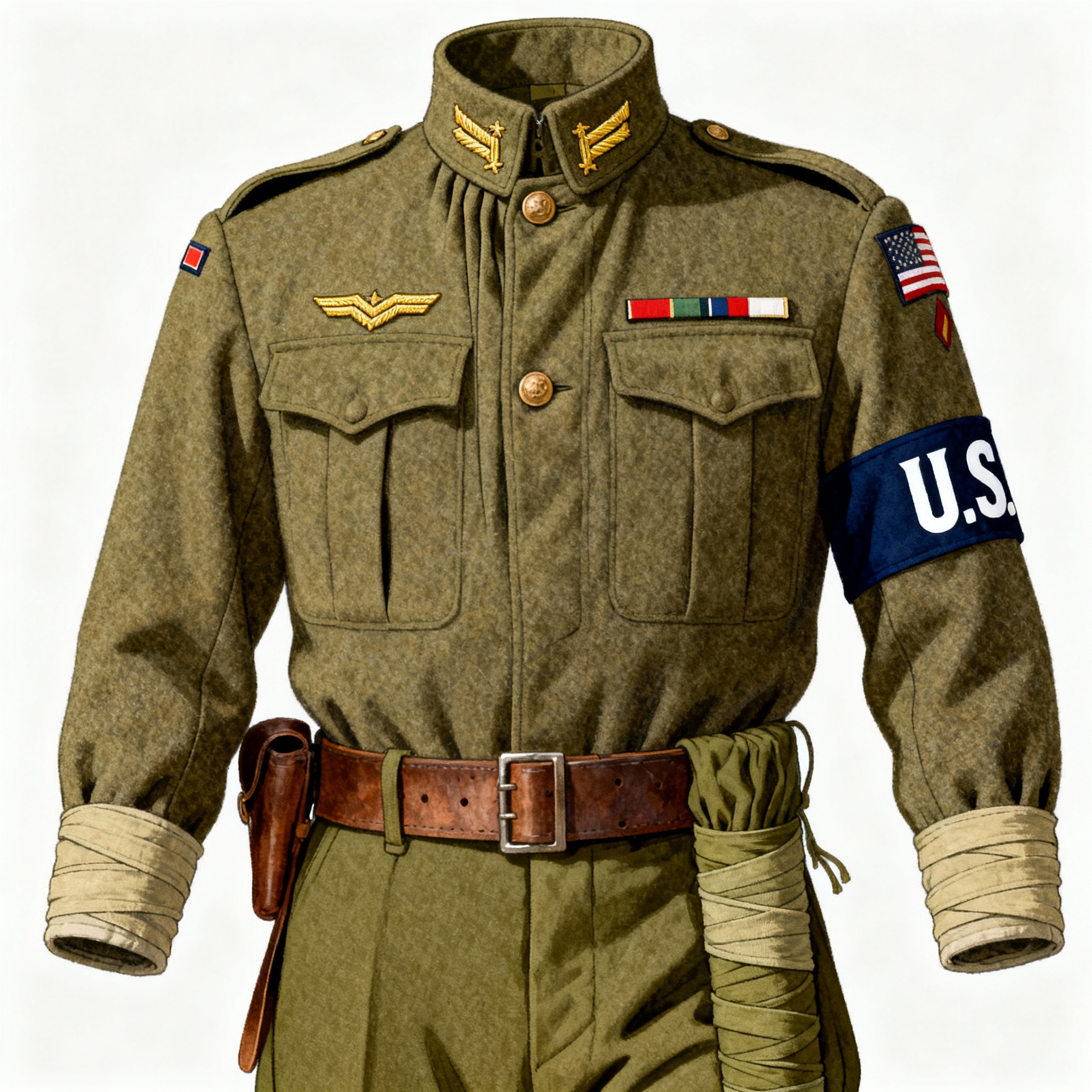
WWI U.S. Soldier Uniforms: A Rank Identification Guide
Published on Oct 02, 2025
Introduction: Are You Sure That Army Coat Is Authentic? Over 60% Are Reproductions.
If you're fascinated by war history and military collectibles, you're not alone. The market for WWI and WWII memorabilia has grown by over 35% in the past decade, with coats and uniforms being some of the most sought-after items. But here’s the twist—more than 60% of "original" WW2 army coats sold online are actually reproductions.
That’s why learning how to identify real military uniforms from the World Wars is critical for collectors, re-enactors, or history enthusiasts. This article walks you through everything you need to know—from identifying the real WW2 army coat to recognising the subtle differences in WW1 flying jackets, WW1 pants, and even WW2 leather coats.
Why Uniform Identification Matters
Identifying uniforms accurately is more than just a hobby—it helps preserve history. Here's why it’s important:
- ✅ Avoid scams when buying collectibles
- ✅ Preserve authenticity in museum curation or reenactments
- ✅ Understand the story behind each piece
- ✅ Build a meaningful collection rooted in real history
WW2 Army Coat: Features to Identify Original Gear
The WW2 army coat is one of the most iconic pieces of American military apparel. Whether you're browsing a flea market or diving into your grandfather’s attic, here’s how to tell if that coat is the real deal:
1. Material & Stitching
- Original WW2 coats were made from olive drab wool, sometimes with a blend of rayon.
- Check for tight, uniform stitching and reinforced seams—modern reproductions often skip this detail.
2. Label & Manufacturer Tags
- Look for original tags inside the collar or chest area.
- Authentic tags include contract numbers, manufacturing dates (e.g., 1942), and military acceptance stamps.
3. Button & Hardware Detail
- Original buttons were often made of Bakelite or metal with U.S. Army insignia.
- Zippers, if present, should be from period manufacturers like Talon, Conmar, or Crown.
WW1 Flying Jacket vs WW2 Leather Coat: What’s the Difference?
While both jackets are visually striking, several differences can help you determine their origins:
WW1 Flying Jacket (1914–1918)
- Typically made of sheepskin or heavy leather with fleece lining.
- Shorter cut to accommodate cockpit movement.
- Often lacks military insignia; used more for utility than presentation.
WW2 Leather Coat (1939–1945)
- Sleek, longer design with full lining.
- Often features rank insignia, patches, and specific branch markings (Army Air Forces, etc.).
- More structured, designed for presentation and practicality.
Pro Tip:
Check the inside lining. WW1 jackets often used natural sheep fleece, while WW2 versions started incorporating synthetic linings toward the later war years.
Common Pitfalls in Military Uniform Identification
Avoid these mistakes to keep your collection authentic and valuable:
❌ Assuming Age = Authenticity
Older-looking doesn’t mean original. Many replicas are artificially aged.
❌ Overlooking Reproduction Tags
Modern replicas may still include a "Made in USA" or "Original Style" tag. Always check carefully.
❌ Confusing Theater-Specific Variations
Uniforms varied by region. A North African campaign coat will look different from one used in Normandy.
❌ Ignoring Stitch Patterns
Reproductions often miss the complex stitching found in authentic pieces.
How to Identify WW1 Pants & World War One Jackets
These two pieces are easily misidentified, especially since WWI uniforms were simpler than their WWII counterparts.
WW1 Pants (Breeches)
- High-waisted, often wool, with lace-up calves or leg straps.
- No zippered fly—I used buttons instead.
- Often dark khaki or olive drab.
World War One Jacket (Tunic)
- Short collar stand or "mandarin" collar.
- Patch pockets with scalloped flaps.
- Shoulder epaulettes were common but lacked insignia until the late war.
Field Tip:
WW1 tunics have a squarer cut and are lighter in weight compared to the bulkier WW2 tunics or coats.
Actionable Steps to Verify Authentic Military Uniforms
- Research the Item First
- Use government-issued manuals or collector’s guides.
- Search for official contract numbers or military issue references.
- Compare With Museum Specimens
- Many museums now have virtual catalogues you can access for free.
- Ask for Provenance
- Authenticity increases with documents or photographs linking the item to its wearer.
- Use a UV Light
- Synthetic threads glow under UV light—natural WWII materials do not.
- Consult Online Forums or Collectors
- Reddit’s r/MilitaryCollecting or specialised Facebook groups are gold mines of info.
Current Trends in Uniform Collecting (2025 Edition)
Here’s what’s trending in the world of military collectibles right now:
- 📈 Increased interest in lesser-known units, like African American regiments and the Women’s Army Corps.
- 💡 Restoration and conservation tools are booming—collectors want to preserve, not just display.
- 🌍 Global trade in military gear is growing—watch out for international replicas.
- 🎥 Media influence: Shows like Masters of the Air have skyrocketed demand for WW2 leather coats and flight jackets.
Storage and Care Tips for Your Collection
Preserving your military uniforms is just as important as acquiring them:
- Store in cool, dry conditions—avoid direct sunlight.
- Use acid-free tissue for folding and support.
- Avoid hanging heavy wool coats—lay them flat instead.
- Use cedar blocks for moth protection (never mothballs—they can stain).
Conclusion: Make History Come Alive With Every WW2 Army Coat You Find
Identifying military uniforms like the WW2 army coat or WW1 flying jacket isn't just a niche hobby—it's a doorway to understanding the human stories behind history. With these tips, you can build a collection that's authentic, respected, and historically significant.
